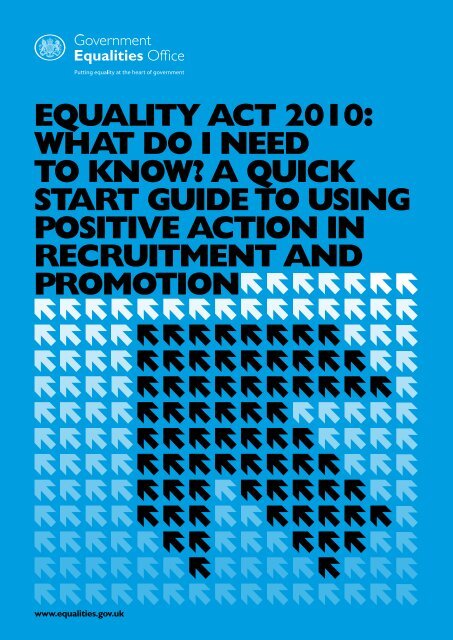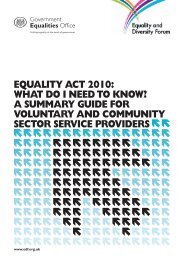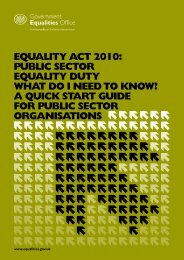A quick start guide to using positive action in recruitment ... - Gov.uk
A quick start guide to using positive action in recruitment ... - Gov.uk
A quick start guide to using positive action in recruitment ... - Gov.uk
Create successful ePaper yourself
Turn your PDF publications into a flip-book with our unique Google optimized e-Paper software.
EQUALITY ACT 2010:<br />
WHAT DO I NEED<br />
TO KNOW A QUICK<br />
START GUIDE TO USING<br />
POSITIVE ACTION IN<br />
RECRUITMENT AND<br />
PROMOTION<br />
www.equalities.gov.<strong>uk</strong>
Foreword<br />
The Equality Act 2010 replaces the previous antidiscrim<strong>in</strong>ation<br />
laws with a s<strong>in</strong>gle Act. It simplifies the<br />
law, remov<strong>in</strong>g <strong>in</strong>consistencies and mak<strong>in</strong>g it easier<br />
for people <strong>to</strong> understand and comply with it. It also<br />
strengthens the law <strong>in</strong> important ways <strong>to</strong> help tackle<br />
discrim<strong>in</strong>ation and <strong>in</strong>equality.<br />
This <strong>quick</strong> <strong>start</strong> <strong>guide</strong> is <strong>in</strong>tended <strong>to</strong> help employers<br />
understand how they can use new <strong>positive</strong> <strong>action</strong><br />
provisions <strong>to</strong> improve diversity <strong>in</strong> their workforce<br />
when recruit<strong>in</strong>g and promot<strong>in</strong>g candidates.The new<br />
provisions come <strong>in</strong><strong>to</strong> force on 6 April 2011.
Introduction<br />
The Equality Act 2010 br<strong>in</strong>gs <strong>to</strong>gether, harmonises<br />
and, <strong>in</strong> some respects, extends exist<strong>in</strong>g equality law.<br />
It aims <strong>to</strong> make the law more consistent, clearer and<br />
easier <strong>to</strong> follow <strong>in</strong> order <strong>to</strong> make society fairer.<br />
On 1 Oc<strong>to</strong>ber 2010, general <strong>positive</strong> <strong>action</strong><br />
provisions came <strong>in</strong><strong>to</strong> force.These replicate<br />
provisions <strong>in</strong> earlier legislation and allow employers<br />
<strong>to</strong> target measures such as dedicated tra<strong>in</strong><strong>in</strong>g<br />
<strong>to</strong> groups, such as women or people from<br />
ethnic m<strong>in</strong>orities, who are under-represented or<br />
disadvantaged <strong>in</strong> the workplace, or <strong>to</strong> meet their<br />
particular needs. Guidance is available at:<br />
http://www.equalities.gov.<strong>uk</strong>/staimm6geo/<br />
pdf/401727_EqualityAct2010_PositiveAction_acc.pdf<br />
The rema<strong>in</strong><strong>in</strong>g <strong>positive</strong> <strong>action</strong> provisions, relat<strong>in</strong>g<br />
specifically <strong>to</strong> <strong>recruitment</strong> and promotion <strong>in</strong><br />
employment, come <strong>in</strong><strong>to</strong> force on 6 April 2011.<br />
This <strong>quick</strong> <strong>start</strong> <strong>guide</strong> will help employers<br />
understand when and how they can use the new<br />
<strong>positive</strong> <strong>action</strong> provisions when recruit<strong>in</strong>g and<br />
promot<strong>in</strong>g candidates.<br />
Who is affected<br />
The Act protects people from be<strong>in</strong>g treated<br />
less favourably because they have a protected<br />
characteristic.The relevant protected characteristics<br />
<strong>in</strong> employment are:<br />
• age<br />
• disability (see page 10)<br />
• gender reassignment<br />
• marriage and civil partnership<br />
• pregnancy and maternity<br />
• race (<strong>in</strong>clud<strong>in</strong>g ethnic or national orig<strong>in</strong>s, colour<br />
and nationality)<br />
• religion or belief (<strong>in</strong>clud<strong>in</strong>g lack of belief)<br />
• sex<br />
• sexual orientation<br />
Positive <strong>action</strong> applies <strong>to</strong> all these protected<br />
characteristics. Positive <strong>action</strong> provisions mean<br />
that it is not unlawful discrim<strong>in</strong>ation <strong>to</strong> take special<br />
measures aimed at alleviat<strong>in</strong>g disadvantage or<br />
under-representation experienced by those with<br />
any of these characteristics.<br />
3
Example<br />
An employer has very few women <strong>in</strong><br />
its senior management team. Under<br />
the general <strong>positive</strong> <strong>action</strong> provisions it<br />
offers a development programme which<br />
is only open <strong>to</strong> women <strong>to</strong> help female<br />
staff compete for management positions.<br />
This is not unlawful discrim<strong>in</strong>ation<br />
aga<strong>in</strong>st male staff, because it is allowed<br />
by the <strong>positive</strong> <strong>action</strong> provisions.<br />
Positive <strong>action</strong> is entirely voluntary – there<br />
is no requirement for an employer <strong>to</strong> use<br />
either the general provisions or those<br />
relat<strong>in</strong>g <strong>to</strong> <strong>recruitment</strong> and promotion.<br />
What is <strong>positive</strong> <strong>action</strong> when<br />
it applies <strong>to</strong> <strong>recruitment</strong> and<br />
promotion<br />
The new <strong>positive</strong> <strong>action</strong> provisions mean that it<br />
is not unlawful <strong>to</strong> recruit or promote a candidate<br />
who is of equal merit <strong>to</strong> another candidate, if the<br />
employer reasonably th<strong>in</strong>ks the candidate:<br />
• has a protected characteristic that is underrepresented<br />
<strong>in</strong> the workforce; or<br />
• that people with that characteristic suffer a<br />
disadvantage connected <strong>to</strong> that characteristic.<br />
Example<br />
A bank has a vacancy for one of its<br />
senior jobs.All the other senior jobs at<br />
that level are done by men.The bank<br />
conducts a <strong>recruitment</strong> exercise and<br />
at the end of a str<strong>in</strong>gent and objective<br />
process f<strong>in</strong>ds that two applicants – a<br />
man and a woman – could do the job<br />
equally well.The bank could decide <strong>to</strong><br />
take <strong>positive</strong> <strong>action</strong> and give the job<br />
<strong>to</strong> the woman. But the bank couldn’t<br />
give the job <strong>to</strong> the woman if the man<br />
would be able <strong>to</strong> do the job better than<br />
her – that would be unlawful direct<br />
discrim<strong>in</strong>ation aga<strong>in</strong>st the man.<br />
What has changed<br />
Current <strong>positive</strong> <strong>action</strong> provisions <strong>in</strong> employment<br />
relate <strong>to</strong> tra<strong>in</strong><strong>in</strong>g or encouragement – such as<br />
men<strong>to</strong>r<strong>in</strong>g schemes for ethnic m<strong>in</strong>ority staff where<br />
they are under-represented <strong>in</strong> senior roles, or<br />
open days <strong>to</strong> encourage women applicants <strong>in</strong><br />
male-dom<strong>in</strong>ated sec<strong>to</strong>rs.The exist<strong>in</strong>g forms of<br />
<strong>positive</strong> <strong>action</strong> cannot be used as part of the actual<br />
appo<strong>in</strong>tment process.<br />
The Act conta<strong>in</strong>s new provisions <strong>to</strong> allow <strong>positive</strong><br />
<strong>action</strong> specifically <strong>in</strong> the process of <strong>recruitment</strong> and<br />
promotion, <strong>in</strong> limited circumstances.<br />
However, <strong>positive</strong> <strong>action</strong> does not allow an<br />
employer <strong>to</strong> appo<strong>in</strong>t a less suitable candidate<br />
just because that candidate has a protected<br />
characteristic that is under-represented or<br />
disadvantaged.<br />
4
How do the new <strong>positive</strong> <strong>action</strong><br />
provisions <strong>in</strong> <strong>recruitment</strong> and<br />
promotion work<br />
Positive <strong>action</strong> <strong>in</strong> <strong>recruitment</strong> and promotion can<br />
be used where an employer reasonably th<strong>in</strong>ks<br />
that people with a protected characteristic are<br />
under-represented <strong>in</strong> the workforce, or suffer<br />
a disadvantage connected <strong>to</strong> that protected<br />
characteristic. (see page 7)<br />
In practice it allows an employer faced with mak<strong>in</strong>g<br />
a choice between two or more candidates who are<br />
of equal merit <strong>to</strong> take <strong>in</strong><strong>to</strong> consideration whether<br />
one is from a group that is disproportionately<br />
under-represented or otherwise disadvantaged<br />
with<strong>in</strong> the workforce. (see page 6)<br />
This is sometimes called either a ‘tie-breaker’ or the<br />
‘tipp<strong>in</strong>g po<strong>in</strong>t’.<br />
Example<br />
A counsell<strong>in</strong>g service for teenagers has<br />
no employees who are Muslim, despite<br />
be<strong>in</strong>g located <strong>in</strong> an area of high Muslim<br />
population.When a vacancy arises, two<br />
candidates of equal merit are <strong>in</strong> a tiebreaker<br />
situation with the employer<br />
hav<strong>in</strong>g <strong>to</strong> f<strong>in</strong>d some way <strong>to</strong> choose<br />
between them. One candidate is Muslim<br />
and the other candidate is not.The<br />
service manager could choose <strong>to</strong> offer<br />
the job <strong>to</strong> the Muslim candidate.This<br />
would be allowed under the <strong>positive</strong><br />
<strong>action</strong> provisions, so the non-Muslim<br />
candidate could not claim unlawful<br />
religious discrim<strong>in</strong>ation.<br />
But this k<strong>in</strong>d of <strong>positive</strong> <strong>action</strong> is only allowed<br />
where it is a proportionate way of address<strong>in</strong>g the<br />
under-representation or disadvantage. (see page 8)<br />
5
Positive <strong>action</strong> can be used at any time <strong>in</strong> the<br />
<strong>recruitment</strong> or promotion process.<br />
Example<br />
An accountancy firm is recruit<strong>in</strong>g for its<br />
graduate tra<strong>in</strong><strong>in</strong>g scheme.After the first<br />
round of assessment the firm decides<br />
<strong>to</strong> shortlist 20 candidates.There is a<br />
tie-breaker situation for the 20th place<br />
on the shortlist as there are a number<br />
of candidates of equal merit.The firm<br />
decides <strong>to</strong> use the <strong>positive</strong> <strong>action</strong><br />
provisions <strong>to</strong> advance a candidate from<br />
a BME background <strong>to</strong> the next round of<br />
<strong>recruitment</strong>, because people from BME<br />
backgrounds are under-represented<br />
<strong>in</strong> the firm.This would mean that the<br />
non-BME candidates could not claim<br />
unlawful race discrim<strong>in</strong>ation for not<br />
be<strong>in</strong>g put on the shortlist.<br />
However, it is expected that, <strong>in</strong> the vast majority<br />
of cases, any use of <strong>positive</strong> <strong>action</strong> as a ‘tie-breaker’<br />
between candidates who are of equal merit for a<br />
particular post will be at the end of the <strong>recruitment</strong><br />
process, at the actual po<strong>in</strong>t of appo<strong>in</strong>tment.At that<br />
stage all of the relevant fac<strong>to</strong>rs that the employer<br />
will need <strong>to</strong> know <strong>in</strong> order <strong>to</strong> determ<strong>in</strong>e whether<br />
or not the candidates are truly as qualified as each<br />
other should have been established.<br />
What does ‘equal merit’ mean<br />
In order <strong>to</strong> use <strong>positive</strong> <strong>action</strong> provisions <strong>in</strong> a tiebreaker<br />
situation, the employer must first establish<br />
that the candidates are of equal merit.<br />
Employers should establish a set of criteria aga<strong>in</strong>st<br />
which candidates will be assessed when apply<strong>in</strong>g for<br />
a job.This can take <strong>in</strong><strong>to</strong> account a candidate’s overall<br />
ability, competence and professional experience<br />
<strong>to</strong>gether with any relevant formal or academic<br />
qualifications, as well as any other qualities required<br />
<strong>to</strong> carry out the particular job.<br />
However, employers should ensure that any<br />
criteria do not <strong>in</strong>directly discrim<strong>in</strong>ate aga<strong>in</strong>st<br />
people who share a protected characteristic –<br />
for example, a requirement that staff must work<br />
shift patterns that mean they have <strong>to</strong> be on-call<br />
at certa<strong>in</strong> fixed times might put women, who are<br />
more likely <strong>to</strong> be responsible for childcare issues,<br />
at a disproportionate disadvantage.This would be<br />
unlawful <strong>in</strong>direct discrim<strong>in</strong>ation unless it could be<br />
shown that the need for these work patterns could<br />
be objectively justified.<br />
Employers must consider whether candidates<br />
are of equal merit <strong>in</strong> relation <strong>to</strong> the specific job<br />
or position they are apply<strong>in</strong>g for.While two<br />
candidates may be considered <strong>to</strong> be of equal merit<br />
for one particular post, the same two candidates<br />
might not be equally suitable for another job.<br />
6
Example<br />
A health and fitness club is faced with<br />
mak<strong>in</strong>g a choice between two applicants<br />
for a job as the manager of a leisure<br />
facility. One, a woman, has recently<br />
completed a Leisure Management<br />
Foundation Degree course but has<br />
little practical experience.The other<br />
candidate is a man who has no formal<br />
qualifications but has several years<br />
experience of work<strong>in</strong>g <strong>in</strong> leisure<br />
centres. Hav<strong>in</strong>g <strong>in</strong>terviewed both<br />
candidates, the employer decides that<br />
both could do the job <strong>to</strong> the same<br />
standard but <strong>in</strong> different ways as each<br />
would br<strong>in</strong>g a different set of skills<br />
and experiences <strong>to</strong> the job.Therefore,<br />
because the candidates are of equal<br />
merit the manager could voluntarily<br />
use the <strong>positive</strong> <strong>action</strong> provisions when<br />
choos<strong>in</strong>g between the candidates and<br />
opt <strong>to</strong> employ the man because all of<br />
the other senior positions at the leisure<br />
complex were held by women.<br />
Example<br />
A retailer advertises for a tra<strong>in</strong>ee<br />
fashion buyer. Among the applicants is<br />
a person who has a degree <strong>in</strong> French.<br />
None of the other applicants has a<br />
degree <strong>in</strong> any subject.The fact that<br />
one candidate has higher academic<br />
qualifications than the others does<br />
not au<strong>to</strong>matically make that person<br />
better qualified for this particular job.<br />
The employer will need <strong>to</strong> decide if<br />
that qualification is a relevant fac<strong>to</strong>r<br />
<strong>in</strong> assess<strong>in</strong>g who might do the job as a<br />
fashion buyer best.<br />
What does ‘reasonably th<strong>in</strong>ks’<br />
mean<br />
Positive <strong>action</strong> <strong>in</strong> <strong>recruitment</strong> and promotion can<br />
be used where an employer reasonably th<strong>in</strong>ks<br />
that people with a protected characteristic are<br />
under-represented <strong>in</strong> the workforce, or suffer<br />
a disadvantage connected <strong>to</strong> that protected<br />
characteristic.<br />
Some <strong>in</strong>formation or evidence will be required<br />
<strong>to</strong> <strong>in</strong>dicate <strong>to</strong> the employer that one of those<br />
conditions exists – but it does not need <strong>to</strong> be<br />
sophisticated statistical data or research. It may<br />
simply <strong>in</strong>volve an employer look<strong>in</strong>g at the profiles<br />
of their workforce and/or mak<strong>in</strong>g enquiries of<br />
other comparable employers <strong>in</strong> the area or sec<strong>to</strong>r<br />
as a whole.Additionally, it could <strong>in</strong>volve look<strong>in</strong>g<br />
at national data such as labour force surveys for<br />
7
a national or local picture of the work situation<br />
for particular groups who share a protected<br />
characteristic.A decision could be based on<br />
qualitative evidence which may be obta<strong>in</strong>ed <strong>in</strong><br />
various ways, for <strong>in</strong>stance through discussion with<br />
workers or their representatives.<br />
Example<br />
A DIY cha<strong>in</strong> beg<strong>in</strong>s plann<strong>in</strong>g a new<br />
<strong>recruitment</strong> programme. In consider<strong>in</strong>g<br />
how <strong>to</strong> create a more diverse<br />
workforce the company realises that<br />
it does not keep detailed records on<br />
the personal details of its employees.<br />
However, the Area Manager is able<br />
<strong>to</strong> demonstrate that it is reasonable<br />
for him <strong>to</strong> th<strong>in</strong>k that there are a<br />
disproportionately low number of<br />
women <strong>in</strong> the workforce from his<br />
knowledge of who works for him and<br />
by consult<strong>in</strong>g with his local branch<br />
managers.The employer could decide <strong>to</strong><br />
use <strong>positive</strong> <strong>action</strong> <strong>in</strong> aim<strong>in</strong>g <strong>to</strong> address<br />
the number of women <strong>in</strong> the workforce.<br />
Tak<strong>in</strong>g <strong>positive</strong> <strong>action</strong> based on that<br />
<strong>in</strong>formation would usually be lawful.<br />
However, it should be acknowledged that some<br />
protected characteristics are more readily<br />
identifiable than others – for <strong>in</strong>stance, a person’s<br />
gender may be easier <strong>to</strong> establish than their<br />
religion or belief or their sexual orientation – and<br />
so it may be more difficult <strong>to</strong> determ<strong>in</strong>e if there<br />
is any under-representation of those with certa<strong>in</strong><br />
protected characteristics.<br />
What does ‘proportionate’<br />
mean<br />
‘Proportionate’ refers <strong>to</strong> the balanc<strong>in</strong>g of all the<br />
relevant fac<strong>to</strong>rs. In consider<strong>in</strong>g <strong>us<strong>in</strong>g</strong> the <strong>positive</strong><br />
<strong>action</strong> provisions, an employer will need <strong>to</strong> balance<br />
the seriousness of the disadvantage suffered or<br />
the extent <strong>to</strong> which people with a protected<br />
characteristic are under-represented aga<strong>in</strong>st the<br />
impact that the proposed <strong>action</strong> may have on other<br />
people.<br />
When th<strong>in</strong>k<strong>in</strong>g about proportionality, an<br />
employer may f<strong>in</strong>d it helpful <strong>to</strong> consider if the<br />
proposed <strong>action</strong> is the only way <strong>to</strong> address the<br />
under-representation or disadvantage effectively, or if<br />
it would it be possible <strong>to</strong> achieve the same effect by<br />
other <strong>action</strong>s that are less likely <strong>to</strong> result <strong>in</strong> the less<br />
favourable treatment of other people.<br />
Example<br />
A small voluntary organisation has<br />
five employees, who are all women.<br />
The organisation acknowledges that it<br />
would prefer <strong>to</strong> have a gender-balanced<br />
workforce but feels that, because of<br />
its size, it would not be proportionate<br />
<strong>to</strong> use <strong>positive</strong> <strong>action</strong> provisions <strong>in</strong><br />
<strong>recruitment</strong> <strong>to</strong> address this, especially<br />
as men are well represented <strong>in</strong> similar<br />
organisations throughout the sec<strong>to</strong>r.<br />
8
Rout<strong>in</strong>ely favour<strong>in</strong>g people with protected<br />
characteristics<br />
The new <strong>positive</strong> <strong>action</strong> provisions make it clear<br />
that employers must not adopt policies or practices<br />
designed <strong>to</strong> rout<strong>in</strong>ely favour candidates with a<br />
certa<strong>in</strong> protected characteristic, even where there<br />
is evidence of under-representation or disadvantage.<br />
All suitably qualified candidates must be considered<br />
on their <strong>in</strong>dividual merits for the post <strong>in</strong> question.<br />
Where one candidate is clearly superior or<br />
better qualified for the job than the others, then<br />
an employer should offer the position <strong>to</strong> that<br />
candidate.<br />
However, this does not prevent an employer hav<strong>in</strong>g<br />
a rout<strong>in</strong>e policy of be<strong>in</strong>g prepared <strong>to</strong> use <strong>positive</strong><br />
<strong>action</strong> where it is appropriate for it <strong>to</strong> do so.An<br />
employer may go <strong>in</strong><strong>to</strong> an appo<strong>in</strong>tment exercise<br />
prepared <strong>to</strong> use the ‘tie-breaker’ provisions, only <strong>to</strong><br />
identify a clearly superior candidate – any notion of<br />
<strong>us<strong>in</strong>g</strong> the ‘tie-breaker’ would then become irrelevant.<br />
Artificially low thresholds<br />
Appo<strong>in</strong>tments should always be made on merit. If<br />
one candidate is superior <strong>to</strong> another the position<br />
should be offered <strong>to</strong> that candidate. If the pass mark<br />
<strong>in</strong> an assessment is set at 70% and one candidate<br />
scores 71% and another score 91%, it would<br />
generally be wrong <strong>to</strong> consider that just because<br />
both passed the m<strong>in</strong>imum success threshold the<br />
two candidates are of equal merit.<br />
Example<br />
A local authority wishes <strong>to</strong> diversify<br />
its workforce and undertakes a large<br />
<strong>recruitment</strong> exercise. In an attempt<br />
<strong>to</strong> create a large pool of ‘qualified’<br />
people from which it can cherry-pick<br />
those with the relevant protected<br />
characteristics <strong>to</strong> make its workforce<br />
more diverse, it sets a very low pass<br />
mark for the assessment <strong>to</strong> make<br />
sure that a lot of people pass. Pick<strong>in</strong>g<br />
someone with a particular protected<br />
characteristic from the pool <strong>in</strong><br />
preference <strong>to</strong> someone who achieved<br />
a higher score and was clearly better<br />
qualified for the job but didn’t have a<br />
targeted protected characteristic would<br />
not be allowed by the <strong>positive</strong> <strong>action</strong><br />
provisions and would be likely <strong>to</strong> be<br />
unlawful discrim<strong>in</strong>ation.<br />
How is what the new <strong>positive</strong> <strong>action</strong><br />
provisions allow different from <strong>positive</strong><br />
discrim<strong>in</strong>ation<br />
Positive discrim<strong>in</strong>ation is recruit<strong>in</strong>g or promot<strong>in</strong>g a<br />
person solely because they have a relevant<br />
protected characteristic. Sett<strong>in</strong>g quotas <strong>to</strong> recruit or<br />
promote a particular number or proportion of<br />
people with protected characteristics is also <strong>positive</strong><br />
discrim<strong>in</strong>ation. Positive discrim<strong>in</strong>ation is unlawful <strong>in</strong><br />
Great Brita<strong>in</strong>. However, it is important <strong>to</strong> note that<br />
it is not unlawful for an employer <strong>to</strong> treat a<br />
disabled person more favourably <strong>in</strong> comparison <strong>to</strong><br />
a non-disabled person (please see ‘Disability’ on<br />
page 10).<br />
9
Example<br />
A department s<strong>to</strong>re employs n<strong>in</strong>e senior<br />
managers but only two of them are<br />
women.When a vacancy arises it seeks<br />
<strong>to</strong> address this under-representation<br />
by only <strong>in</strong>terview<strong>in</strong>g women applicants,<br />
regardless of whether they meet the<br />
criteria for the post.This would be<br />
<strong>positive</strong> discrim<strong>in</strong>ation so would be<br />
unlawful.<br />
Example<br />
A supermarket reviews its workforce<br />
data and f<strong>in</strong>ds that 80% of its employees<br />
are under the age of 35.When next<br />
recruit<strong>in</strong>g, the supermarket manager<br />
sets a quota for 50% of new recruits<br />
<strong>to</strong> be over the age of 35, regardless<br />
of whether they are of equal merit <strong>to</strong><br />
other applicants under the age of 35.<br />
This would be <strong>positive</strong> discrim<strong>in</strong>ation so<br />
would be unlawful.<br />
Example<br />
A call centre wishes <strong>to</strong> diversify the<br />
ethnicity of its workforce as it is aware<br />
that it is currently predom<strong>in</strong>antly white<br />
despite be<strong>in</strong>g based <strong>in</strong> an area with a<br />
large Indian population.After <strong>in</strong>terview<br />
the <strong>to</strong>p two candidates are both white<br />
– but <strong>in</strong> a bid <strong>to</strong> create greater diversity<br />
the company appo<strong>in</strong>ts the third placed<br />
candidate because he is Indian.This<br />
would be <strong>positive</strong> discrim<strong>in</strong>ation so<br />
would be unlawful.<br />
Disability<br />
Positive <strong>action</strong> applies <strong>to</strong> all protected characteristics<br />
<strong>in</strong>clud<strong>in</strong>g disability – but it is important <strong>to</strong> note that<br />
it is not unlawful for an employer <strong>to</strong> treat a disabled<br />
person more favourably than a non-disabled person.<br />
Example<br />
The ‘two-ticks’ guaranteed <strong>in</strong>terview<br />
scheme means that an employer will<br />
<strong>in</strong>terview all disabled applicants who<br />
meet the m<strong>in</strong>imum criteria for a job<br />
vacancy.<br />
However, employers can opt <strong>to</strong> use the <strong>positive</strong><br />
<strong>action</strong> provisions <strong>to</strong> overcome disadvantage or<br />
<strong>in</strong>crease the participation of people with a particular<br />
form of impairment.<br />
10
Example<br />
An employer is faced with hav<strong>in</strong>g <strong>to</strong><br />
choose between three candidates of<br />
equal merit for a post. One candidate<br />
has a mobility impairment, another<br />
has a learn<strong>in</strong>g disability and the third<br />
has no form of disability. In order <strong>to</strong><br />
address the under-representation of<br />
people with learn<strong>in</strong>g disabilities with<strong>in</strong><br />
the organisation and <strong>in</strong> the local area,<br />
the employer selects the candidate with<br />
the learn<strong>in</strong>g disability.This would not be<br />
unlawful discrim<strong>in</strong>ation aga<strong>in</strong>st either of<br />
the other candidates.<br />
Further sources of <strong>in</strong>formation<br />
<strong>Gov</strong>ernment Equalities Office has also published<br />
a Step-by-step Guide <strong>to</strong> <strong>us<strong>in</strong>g</strong> Positive Action <strong>in</strong><br />
Recruitment and Promotion.This can be found at:<br />
http://www.equalities.gov.<strong>uk</strong>/<br />
equality_act_2010/equality_act_2010_<br />
what_do_i_n.aspx<br />
A series of Frequently Asked Questions on the<br />
provisions can be found at:<br />
http://www.equalities.gov.<strong>uk</strong>/equality_<br />
act_2010/faqs_on_commencement_of_the_<br />
eq/<strong>positive</strong>_<strong>action</strong>.aspx<br />
The Equality and Human Rights Commission is<br />
the statu<strong>to</strong>ry body established <strong>to</strong> help elim<strong>in</strong>ate<br />
discrim<strong>in</strong>ation and reduce <strong>in</strong>equality. It has issued<br />
a statu<strong>to</strong>ry Code of Practice expla<strong>in</strong><strong>in</strong>g <strong>in</strong> more<br />
detail the law <strong>in</strong> relation <strong>to</strong> employment and<br />
discrim<strong>in</strong>ation. It also produces a range of material<br />
provid<strong>in</strong>g practical guidance on how <strong>to</strong> comply<br />
with the law. www.equalityhumanrights.com<br />
0845 604 6610<br />
Citizens Advice www.citizensadvice.org.<strong>uk</strong><br />
<strong>Gov</strong>ernment Equalities Office<br />
www.equalities.gov.<strong>uk</strong><br />
11
© Crown copyright 2011<br />
JN404427<br />
January 2011







